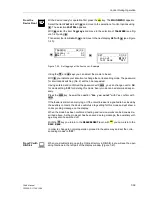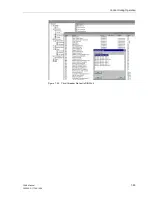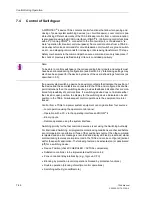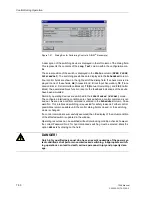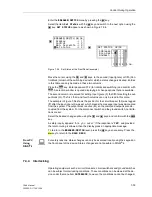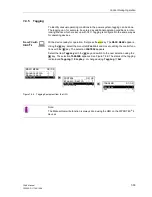
Control During Operation
7-46
7SA6 Manual
C53000-G1176-C156-2
7.4
Control of Switchgear
A SIPROTEC
®
4 device 7SA6 contains control functions that allow for opening and
closing of power system switching devices (i.e. circuit breakers). Local control is pos-
sible utilizing different elements of the 7SA6. Breaker control from a remote location
is also possible using the SCADA interface or DIGSI
®
4. (Performing control functions
with a PC running DIGSI
®
4, connected to the front serial port, is considered a “re-
mote” operation for breaker control purposes.) Some control actions from a 7SA6 in-
clude unsynchronized commands for circuit breakers, circuit switchers, ground switch-
es, etc., and stepping commands for increasing or decreasing transformer LTC steps.
Safety mechanisms in the command path ensure a command can only take place if
the check of previously defined safety criteria is concluded positively.
If a power system switching device has auxiliary contacts that indicate the position of
the device and these contacts are connected to the 7SA6 and configured as double-
point indications then the switching device provides feedback indication that are mon-
itored for plausibility of control actions. If a switching device does not indicate either
the closed or open position, the display for the switching device indicates an invalid
position in the 7SA6. All subsequent control operations to the equipment are inter-
locked.
Control from a 7SA6 to a power system equipment can originate from four sources:
−
Local operation using the operator control panel,
−
Operation with a PC, via the operating interface and DIGSI
®
4
−
Binary inputs,
−
Remote operation using the system interface,
Switching priority for the four command sources is set using the Switching Authority.
For Interlocked Switching, all programmed interlocking conditions are checked before
a control operation is performed. If one of the conditions is not met, then the command
is rejected and an error message is recorded and displayed. Fixed, predefined, stand-
ard interlocking features are implemented in the 7SA6 and can be configured (activat-
ed) for the specific application. The following tests can be activated (on) or deactivated
(off) for a switching device:
•
Device Position (check SCHEDULED = ACTUAL comparison).
•
Substation controller, to be implemented with Version 4.2,
•
Zone controlled / Bay interlocking (e.g., logic via CFC),
•
Blocking by protection (control operations blocked by protective functions),
•
Double operation (blocking of multiple control operations),
•
Switching authority (Local/Remote),
Note:
To be able to control switchgears, the corresponding binary inputs and outputs must
have been allocated during configuration (see Section 5.2). Interlocking settings may
also have been preset for the device by means of the user-defined logic functions (as
described in 5.3).
Summary of Contents for siprotec 7SA6
Page 2: ...Siemens Aktiengesellschaft Book No C53000 G1176 C156 2 ...
Page 18: ...xviii 7SA6 Manual C53000 G1176 C156 2 ...
Page 32: ...Introduction 1 14 7SA6 Manual C53000 G1176 C156 2 ...
Page 82: ...Hardware and Connections 2 50 7SA6 Manual C53000 G1176 C156 2 ...
Page 119: ...SIPROTEC 4 Devices 4 25 7SA6 Manual C53000 G1176 C156 2 Figure 4 20 CFC Logic example ...
Page 190: ...Configuration 5 62 7SA6 Manual C53000 G1176 C156 2 ...
Page 652: ...Installation and Commissioning 8 78 7SA6 Manual C53000 G1176 C156 2 ...
Page 724: ...Technical Data 10 56 7SA6 Manual C53000 G1176 C156 ...
Page 800: ...Appendix A 76 7SA6 Manual C53000 G1176 C156 2 ...
Page 866: ...Appendix B 66 7SA6 Manual C53000 G1176 C156 2 ...








